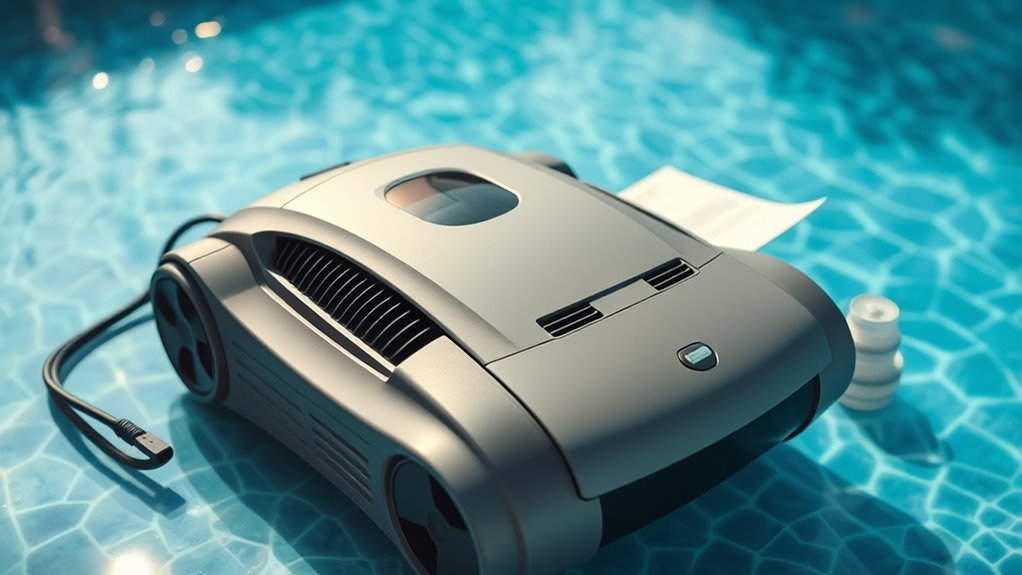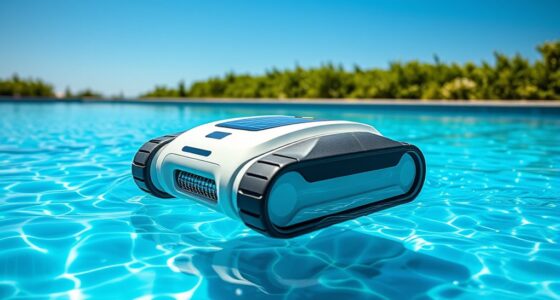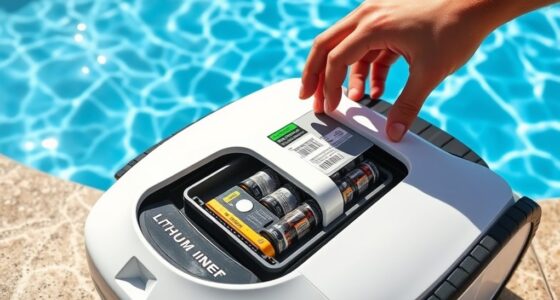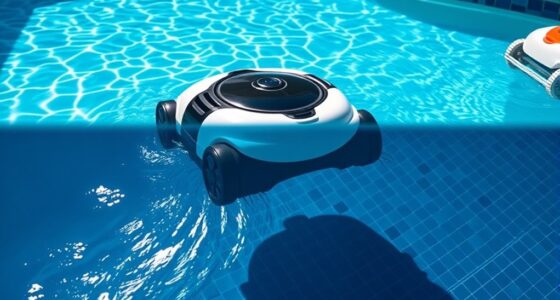To keep your robotic pool cleaner running smoothly, inspect and clean it regularly, especially if you notice inconsistent cleaning or performance issues. service it every 2-4 weeks during heavy use and replace batteries after 1-2 years. Check filters, brushes, and connections, and remove debris before each use. If problems persist or repairs seem complex, consider calling a professional. For detailed steps on servicing your device, continue exploring helpful tips.
Key Takeaways
- Schedule regular inspections monthly or biweekly during heavy use to prevent buildup and performance issues.
- Turn off and remove the cleaner before checking filters, brushes, and power supply components.
- Clean or replace filters every 2-4 weeks, and inspect brushes and wheels for debris or damage.
- Replace batteries every 1-2 years or when runtime decreases significantly.
- Contact a professional if persistent issues, electrical problems, or damage occur despite troubleshooting efforts.
Signs Indicating Your Pool Cleaner Needs Maintenance
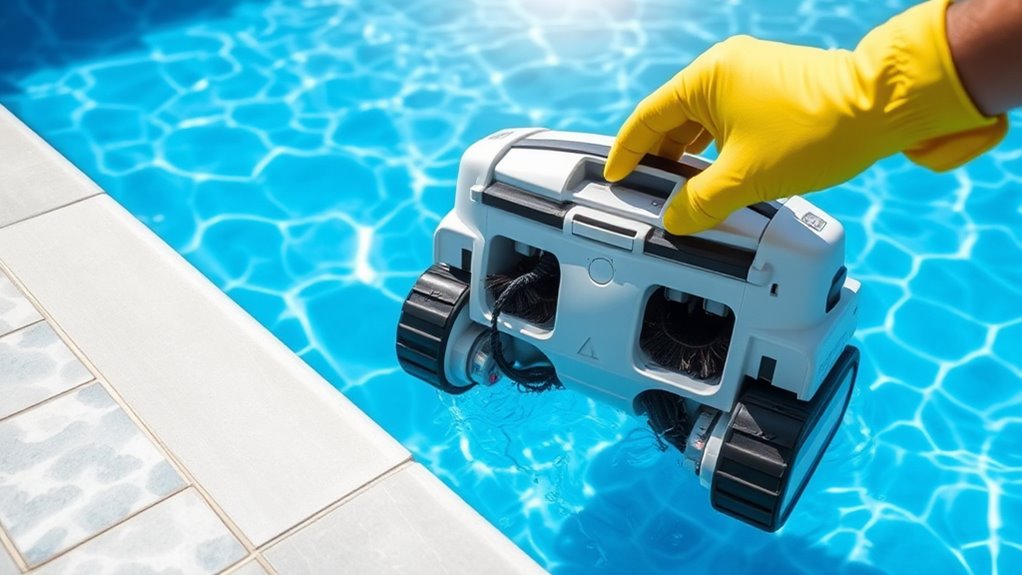
If your robotic pool cleaner isn’t performing as well as it used to, it’s a sign that maintenance may be needed. One common indicator is inconsistent cleaning, which could be caused by dirty filters or worn brushes. Check your pool’s chemical levels, as imbalanced chemicals can create debris buildup that hampers your cleaner’s efficiency. Also, inspect your pool cover; if it’s dirty or not fitting properly, debris can enter the pool and clog the cleaner. Additionally, listen for unusual noises or observe if your cleaner struggles to navigate or reach certain areas. These signs suggest that your robotic cleaner needs a thorough check-up, cleaning, or part replacement to keep it running smoothly and ensure your pool stays pristine. Proper pool maintenance can extend the lifespan of your cleaning device and improve its performance.
Optimal Timing for Servicing Your Robotic Pool Cleaner
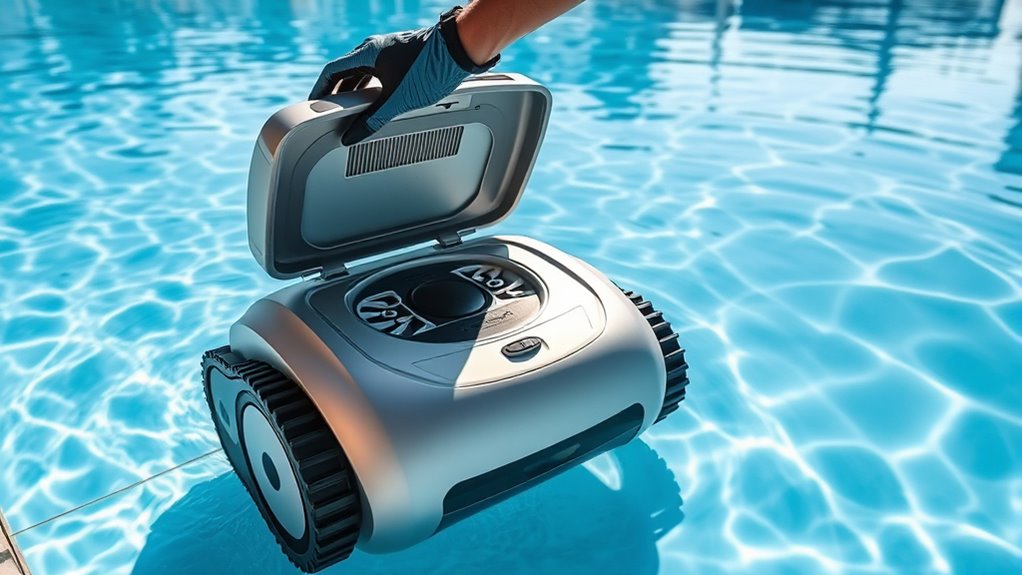
To keep your robotic pool cleaner operating at its best, it is vital to service it regularly rather than waiting for noticeable issues to arise. The best timing for servicing includes inspecting and replacing the battery when it shows signs of decreased runtime or after about 1-2 years, depending on usage. Regular filter maintenance is essential; clean or replace filters every 2-4 weeks, especially during heavy pool use or if debris buildup occurs. Performing these tasks proactively prevents breakdowns and guarantees efficient cleaning. Don’t wait for your device to malfunction—address battery health and filter condition on a routine schedule. Proper filter maintenance is crucial for optimal performance and longevity, as recommended by professional guidelines. This approach helps extend your cleaner’s lifespan and maintains peak performance, ensuring your pool stays clean with minimal hassle. Additionally, checking the water quality regularly can help identify if your device is operating efficiently and if additional cleaning measures are needed. Regularly inspecting and maintaining the battery health can further prevent unexpected failures and improve overall efficiency. Incorporating sound science principles can also help you understand how vibrations might influence your device’s operation. Furthermore, staying informed about AI vulnerabilities related to device software updates can help you implement timely security patches to safeguard your equipment.
Step-by-Step Guide to Cleaning and Inspecting Your Device
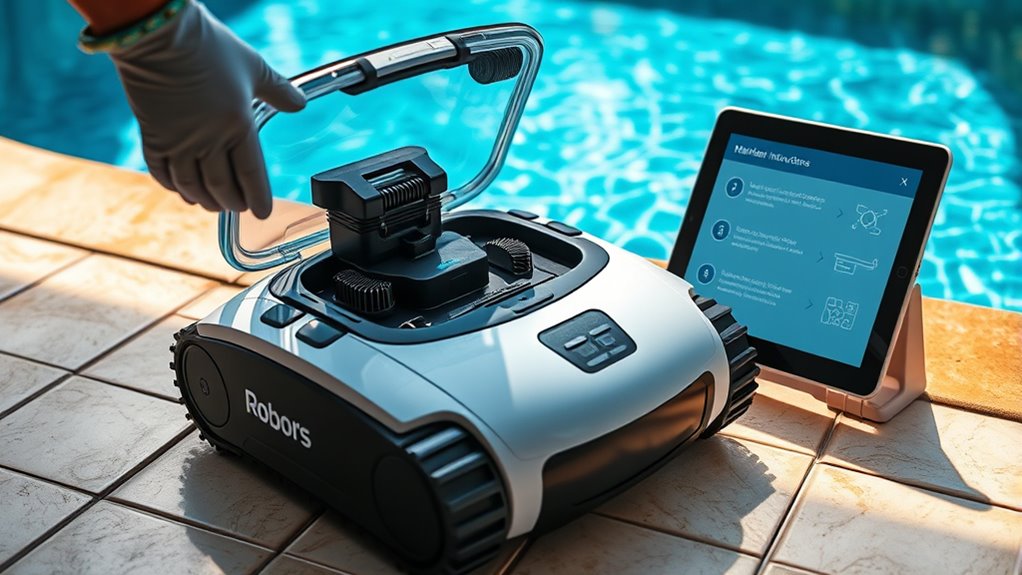
Regular maintenance is key to keeping your robotic pool cleaner performing at its best. Start by turning off the device and removing it from the pool. Check the power supply and inspect the battery for any corrosion or damage; a healthy battery lifespan depends on proper care. Next, open the filter compartment and carefully remove the filter. Rinse it with water to remove debris and dirt, then replace it if it shows signs of wear or clogging. While the filter is out, examine the brushes and wheels for debris or damage, cleaning as needed. Wiping down the body with a damp cloth and checking for loose parts are essential steps as well. Regular inspection and cleaning ensure excellent performance and extend your device’s lifespan. Additionally, consulting the manufacturer’s maintenance guidelines can help you identify specific care needs for your model. Ensuring your device is free of clogged filters and debris will keep it operating efficiently. Incorporating preventive maintenance practices can further reduce the risk of unexpected breakdowns and prolong the life of your robotic cleaner.
Troubleshooting Common Issues During Servicing
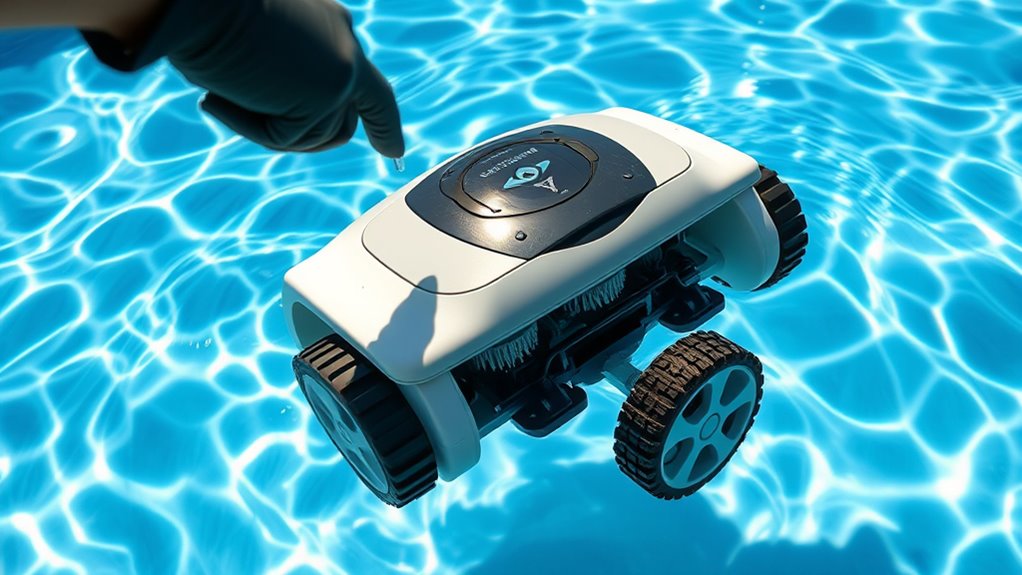
Even with careful maintenance, you might encounter common issues during servicing that can disrupt your robotic pool cleaner’s performance. Troubleshooting tips can help you quickly identify and resolve problems, ensuring your device operates smoothly. If your cleaner isn’t moving as expected, check for tangled brushes or debris blocking the wheels. A proper maintenance routine can significantly reduce the likelihood of such issues. Regular inspection and cleaning of components prevent buildup that could impair movement. Poor cleaning coverage might mean the filters are clogged—clean or replace them. If the robot won’t turn on, verify the power supply and connections. For communication issues, reset the device or update its firmware. Maintaining advanced tuning software ensures your robotic cleaner stays optimized for peak performance. Additionally, regular software updates can fix bugs and improve functionality. Regular robotic maintenance helps prevent many issues, but knowing troubleshooting tips guarantees you can address minor problems promptly, saving time and extending your cleaner’s lifespan. A Kia Tuning approach to maintenance involves understanding the specific needs of your device and performing targeted adjustments. Additionally, ensuring your device is connected to a biodiversity-friendly environment can help improve its efficiency and longevity by reducing environmental stressors. Staying proactive keeps your pool spotless with minimal hassle.
When to Call a Professional for Repairs and Servicing
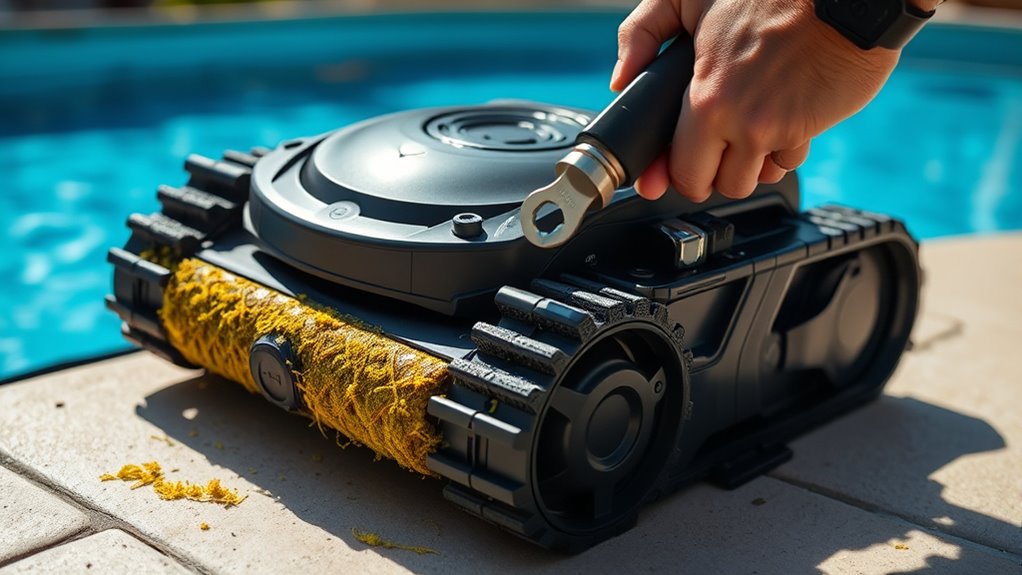
While many minor issues can be resolved through troubleshooting, certain problems require professional expertise to guarantee your robotic pool cleaner operates safely and effectively. If DIY fixes don’t resolve persistent problems, it’s time to call a professional. Avoid trying to repair complex electrical or motor issues yourself, as this could void your warranty or cause further damage. Additionally, if your cleaner is still under warranty, consult the manufacturer before attempting repairs—doing so guarantees you won’t jeopardize coverage. Professional servicing is also essential if you notice unusual noises, persistent malfunctions, or damage to internal parts. Trusting experts helps maintain your cleaner’s performance and preserves your warranty, preventing costly repairs down the line. Keep in mind that service hours vary depending on the provider and location, so planning ahead is advisable. When in doubt, seeking professional help is the safest choice.
Frequently Asked Questions
How Often Should I Replace the Robotic Pool Cleaner’S Brushes?
You should replace your robotic pool cleaner’s brushes when you notice signs of wear, such as fraying or missing bristles. Typically, brush replacement depends on your cleaning frequency; if you clean your pool weekly, check the brushes monthly. Regularly inspecting them helps maintain ideal cleaning performance. Don’t wait until brushes are completely worn out—prompt replacement ensures your cleaner works efficiently and extends its lifespan.
Can I Service My Pool Cleaner Myself Without Special Tools?
You can definitely perform DIY maintenance on your robotic pool cleaner without special tools. Basic troubleshooting, like cleaning filters and brushes, is straightforward and helps keep it running smoothly. Regularly inspect for debris or clogs and replace worn brushes as needed. Following troubleshooting basics, such as checking power connections and cleaning sensors, ensures peak performance. Just refer to your user manual for specific steps, and you’ll be able to maintain your cleaner confidently.
What Safety Precautions Should I Take During Servicing?
Think of servicing your robotic pool cleaner as tending to a delicate garden; safety first keeps everything thriving. You should always unplug the device before starting, ensuring electrical safety. Wear gloves when handling chemicals or cleaning agents, and avoid mixing chemicals to prevent harmful reactions. Keep the area dry and well-ventilated, and follow the manufacturer’s instructions carefully. These precautions protect you from electrical hazards and chemical exposure, making maintenance safe and effective.
Are There Eco-Friendly Cleaning Products Compatible With My Device?
You’re wondering if there are eco-friendly options compatible with your robotic pool cleaner. Luckily, many brands now offer environmentally friendly cleaning agents formulated to be safe for your device and the environment. Look for compatible cleaning agents labeled as eco-friendly or biodegradable. Always check your user manual or manufacturer’s recommendations to guarantee compatibility, so you can maintain your cleaner’s performance while reducing your ecological footprint.
How Do I Store My Robotic Pool Cleaner During the Off-Season?
Your robotic pool cleaner is a powerhouse, so don’t let it sit neglected during off-season! To keep it in top shape, follow simple storage tips for seasonal maintenance. Rinse it thoroughly, remove and dry the filter, and store it in a cool, dry place. Avoid direct sunlight and extreme temperatures. Proper storage guarantees your cleaner stays ready to conquer the pool again, saving you time and hassle when swimming season returns.
Conclusion
Regularly servicing your robotic pool cleaner keeps it running smoothly and extends its lifespan. Did you know that neglecting maintenance can reduce cleaning efficiency by up to 30%? By paying attention to signs like poor cleaning or strange noises, and following simple servicing steps, you can prevent costly repairs. Stay proactive, and your pool will stay sparkling clean all season long. Proper care not only saves you money but also ensures your device performs at its best.
